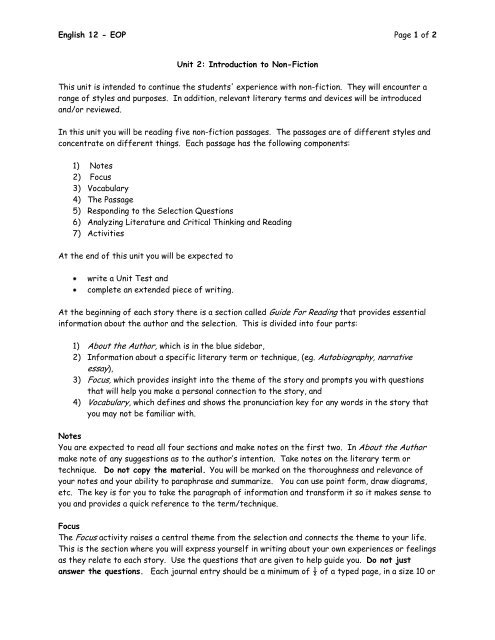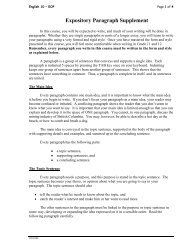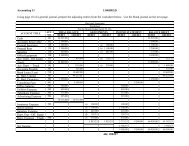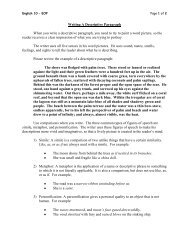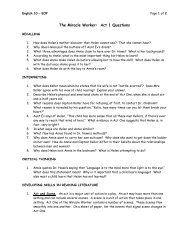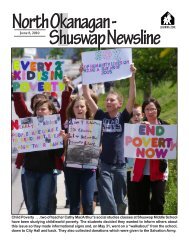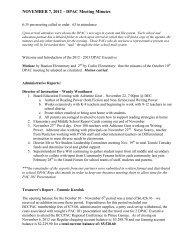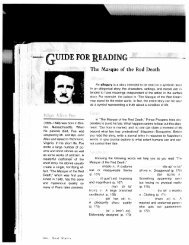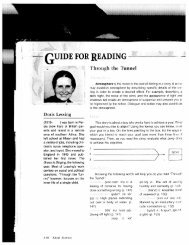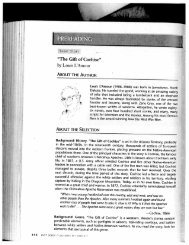Unit 2.pdf
Unit 2.pdf
Unit 2.pdf
Create successful ePaper yourself
Turn your PDF publications into a flip-book with our unique Google optimized e-Paper software.
English 12 - EOP Page 1 of 2<br />
<strong>Unit</strong> 2: Introduction to Non-Fiction<br />
This unit is intended to continue the students' experience with non-fiction. They will encounter a<br />
range of styles and purposes. In addition, relevant literary terms and devices will be introduced<br />
and/or reviewed.<br />
In this unit you will be reading five non-fiction passages. The passages are of different styles and<br />
concentrate on different things. Each passage has the following components:<br />
1) Notes<br />
2) Focus<br />
3) Vocabulary<br />
4) The Passage<br />
5) Responding to the Selection Questions<br />
6) Analyzing Literature and Critical Thinking and Reading<br />
7) Activities<br />
At the end of this unit you will be expected to<br />
write a <strong>Unit</strong> Test and<br />
complete an extended piece of writing.<br />
At the beginning of each story there is a section called Guide For Reading that provides essential<br />
information about the author and the selection. This is divided into four parts:<br />
1) About the Author, which is in the blue sidebar,<br />
2) Information about a specific literary term or technique, (eg. Autobiography, narrative<br />
essay),<br />
3) Focus, which provides insight into the theme of the story and prompts you with questions<br />
that will help you make a personal connection to the story, and<br />
4) Vocabulary, which defines and shows the pronunciation key for any words in the story that<br />
you may not be familiar with.<br />
Notes<br />
You are expected to read all four sections and make notes on the first two. In About the Author<br />
make note of any suggestions as to the author’s intention. Take notes on the literary term or<br />
technique. Do not copy the material. You will be marked on the thoroughness and relevance of<br />
your notes and your ability to paraphrase and summarize. You can use point form, draw diagrams,<br />
etc. The key is for you to take the paragraph of information and transform it so it makes sense to<br />
you and provides a quick reference to the term/technique.<br />
Focus<br />
The Focus activity raises a central theme from the selection and connects the theme to your life.<br />
This is the section where you will express yourself in writing about your own experiences or feelings<br />
as they relate to each story. Use the questions that are given to help guide you. Do not just<br />
answer the questions. Each journal entry should be a minimum of ½ of a typed page, in a size 10 or
English 12 - EOP Page 2 of 2<br />
12 font, although you are welcome to write more if you would like. Your work will be evaluated using<br />
the impromptu writing standards.<br />
Vocabulary<br />
Before your read, consult the words in the Vocabulary section. This will prepare you for the words<br />
in the story that you may be less familiar with. As you read the story, you will notice that there are<br />
also words defined at the bottom of some pages.<br />
The Story<br />
Read the story carefully, re-reading it if necessary. On page 2 of your text there is an explanation<br />
of Reading Actively. There is also an example of how a particular student used this process when<br />
she read Games at Twilight, the first story you will read in this unit. You are expected to actively<br />
read all of your stories. That means you will Question, Visualize, Predict, Connect, and Respond to<br />
them.<br />
Responding to the Selection<br />
There will be questions to answer at the end of each story. The questions are organized into four<br />
sections, three of which you will answer:<br />
1) Your Response requires you to put yourself into the story.<br />
2) Interpreting requires you to make interpretations or critical evaluations based on the facts.<br />
3) Applying requires you to make generalizations about the meaning, significance, or value of<br />
the selection.<br />
Answer each question in complete sentences. Some of the questions have multiple parts, so it is<br />
important to read the question carefully and answer all of the parts. Your responses to these<br />
questions will be evaluated using the Reading Comprehension Standards.<br />
Analyzing Literature and Critical Thinking and Reading<br />
These sections cover literary terminology and techniques. The activity begins with a term and its<br />
definition followed by a number of questions. There are usually multiple parts to this section, and it<br />
is important to answer each part. Answer the question in complete sentences. Additional<br />
information about the term can be found in the Handbook of Literary Terms at the back of the<br />
book. Your responses to these questions will be evaluated using the Reading Comprehension<br />
Standards.<br />
Activities<br />
This section will include additional assignments from the textbook and/or worksheets, and writing<br />
assignments.<br />
Test<br />
At the end of <strong>Unit</strong> One is a unit test, which will assess your understanding of the concepts, rather<br />
than your memory of any particular story you read. You will have to set up a time to write this test<br />
with your instructor.


